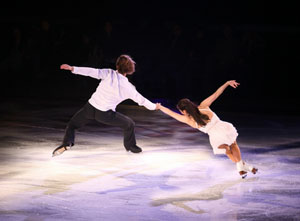Figure-Skating
Skating traces its origins practically back to the origins of human beings. To cross frozen lakes and streams, early humans tied animal bones to their feet and glided through the winter months. Eventually, iron and steel blades replaced the bones and a rough means of travel was transformed into recreation. Skating remained popular among all social classes, but as a competitive sport, only the extremely well-to-done could afford to participate.
Figure skating as we know it today traces its origins directly back to an American, Jackson Haines. Haines was born in New York in 1840 and died in 1875 in Finland after catching pneumonia while traveling by sled from St. Petersburg to Stockholm.
Just before the United States’ Civil War, a skating craze swept over America. It was during this time that Jackson Haines leapt into the limelight with his mastery of skating and dance. He was a true revolutionary in a country where figure skating had laboriously developed a stiff and rigid style. The free and expressive movements of his performances were condemned by many Americans. In 1863 and 1864, he won the Championships of America but he continued to receive cool receptions from his fellow country men. His lack of popularity in America finally prompted him to go to Europe, where he was an immediate success. He was especially popular in Vienna where he gave birth to the so-called "International Style of Figure Skating."
While Jackson gave America its first taste of the international style of figure skating, it was not until the turn of the century that this influence finally began to secure its place in the American Figure Skating community. This event cam about thanks to the efforts of Haines and three other figure skating pioneers: Louis Rubenstein, George H. Browne and Irving Brokaw.
Louis Rubenstein, of Montreal, Canada was one of the first individuals who recognized the merits of the international style and the need for organization in a sport which had largely existed as an informal collection of skating clubs. It was through his efforts that the first attempts to form a national governing body began.
While Rubenstein laid the groundwork for uniform competitions and tests and a future governing body, it was George H. Brown end Irving Brokaw of Cambridge Massachusetts, who put that work into action by means of the first International Figure Skating Champions of American.
Browne who had studied with the leading European skaters of the day while in Davos, Switzerland, was a staunch supporter of the international style of figure skating, authoring several gooks and even developing a new type of skate in order to promote this new method of skating.
Much of the success accomplished by Browne was augmented by Irving Brokaw. Brokaw, who had been influenced by the skating of Jackson Haines, collaborated with Browne throughout much of the early 1900s, demonstrating the international style through the country.
Brokaw was part of the first formal demonstration of the international style in 1908, and was the first American to participate in international style in 1908 and was the first American to participate in international competitions, placing sixth at the 1908 Olympic Games in London.
In 1914, Browne organized the first "International Figure Skating Championships of America" under the auspices of the International Skating Union of America, the governing body for both speed and figure skating during the early 1900s. As a result of the direction brought by the ISU of America and Browne’s efforts to creative uniform standards for skating, the USFSA was formed in 1921 to govern the sport and promote its growth on a nationwide basis.
